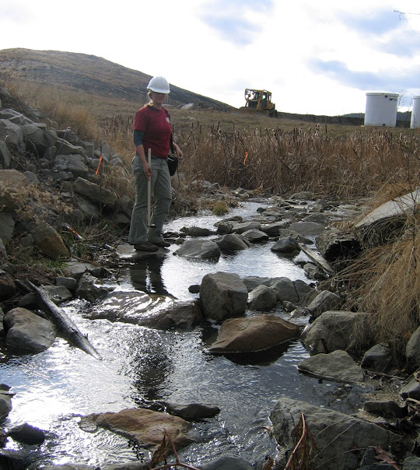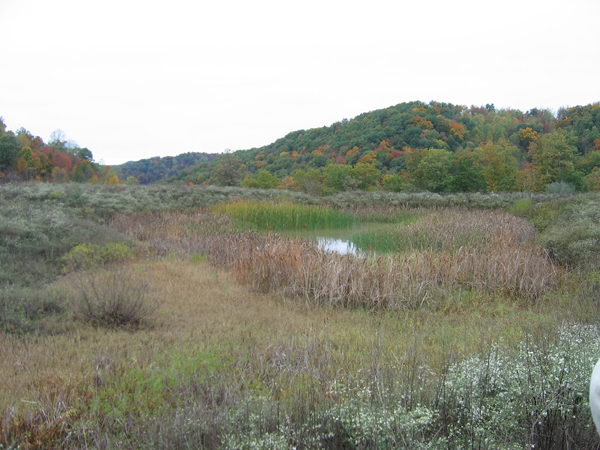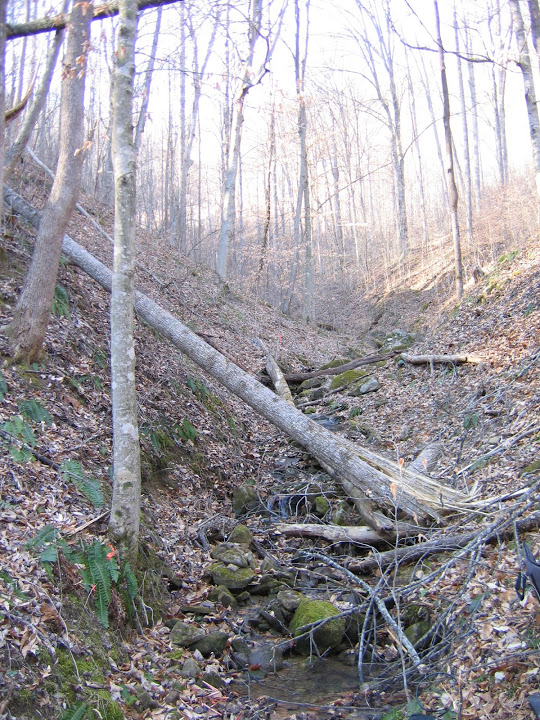Constructed streams on reclaimed mountaintop mines are no naturals, but retain important functions

A constructed stream channel on a reclaimed mountaintop mine (Credit: Gretchen Gingerich)
Mountaintop removal mining in the Appalachians is best known among environmentalists for the habitats it destroys: steep forests are blown away and the rubble often fills in valleys and buries streams.
But once the coal is removed, the reclamation processes also creates new, if ecologically suspect, habitats. Those include constructed channels designed to handle runoff or replace damaged streams to meet regulatory mitigation requirements.
Scientists have assumed the constructed channels offer no ecological value, doing nothing to make up for the biological and chemical functions of the pristine headwater streams they’ve replaced. A recently published study from West Virginia University scientists suggests that isn’t the case.
The study, published in the journal Hydrobiologia, compared water chemistry, biological communities, organic matter processing and other aspects of in-tact headwater streams with those in constructed channels on reclaimed mines. Todd Petty, professor of wildlife and fisheries at West Virginia University, said the results show that the reclaimed channels aren’t a total loss.
“Clearly they’re lower for most of the functions associated with clean, low-conductivity, dilute freshwater headwaters in the Appalachians. That’s a clear outcome, and we never expected to find anything other than that,” said Petty, the study’s lead author. “The values are not zero, however. There are important headwater catchment values that are being performed by these systems, and many of those can be improved upon through improved reclamation.”
It’s difficult to compare pristine landscapes to completely altered ones, Petty said. That’s especially the case on reclaimed mines where the formerly steep forested catchments have been replaced with low-gradient grasslands. That flattening out of the landscape tends to slow down the water in the constructed channels, which start to behave more like wetlands than streams. That made it important for the researchers to focus on measuring characteristics that were relevant across both streams and wetlands.

Constructed channels on reclaimed mines tend to work more like wetlands than streams (Credit: Gretchen Gingerich)
Among the water quality and chemistry parameters the researchers measured were pH, conductivity, dissolved oxygen and temperature. In the constructed channels, dissolved oxygen was lower than the in-tact streams, while the daily mean temperatures, pH and conductivity were higher. Conductivity–a surrogate for total dissolved solids–was a particular concern.
“The key difference is the elevated conductivities,” Petty said. “Those are without question one of these things that just shows up in study after study as being one of the most difficult water quality problems to deal with, and one of the water chemistry factors that clearly has a biological consequence.”
Part of those biological consequences appears to be knocking out sensitive groups of aquatic insects like mayflies, caddisflies and stoneflies, which were poorly represented in the constructed channels. That has an additional effect of limiting decomposition in constructed channels because they lack the “shredder” macroinvertebrate species that physically break down organic matter in streams.
That’s important here, Petty said, because any stream ecologist would tell you that among the most important contributions from headwater streams is their ability to break down terrestrial organic matter and make it biologically available for aquatic organisms.
But while decomposition rates were much lower in constructed channels, they excelled at another dimension of organic matter processing: retention. Their low gradients and emergent plants typical of wetlands led them to hold on to organic matter longer, leading to plenty of decomposition despite lower rates.

A natural Appalachian headwater stream (Credit: Gretchen Gingerich)
One of the motivations behind the study was to highlight where constructed channels were falling short to identify where those aspects could be improved through better reclamation practices. Petty said recent discussion among the restoration community has focused on improving structural issues in constructed channels. Petty said that would make for better looking streams but might not address the chemical issues at the heart of their ecological shortcomings.
Chief among those chemical issues are the high conductivity and dissolved solids produced from mine spoils.
“If our paper does one thing, it’s just to reinforce that the reclamation process can’t lose sight of that,” Petty said. “It’s got to tackle that issue head on. It can’t just make prettier streams in the reclamation process and hope to deal with the essence of the problem.”
Top image: A constructed stream channel on a reclaimed mountaintop mine (Credit: Gretchen Gingerich)





0 comments